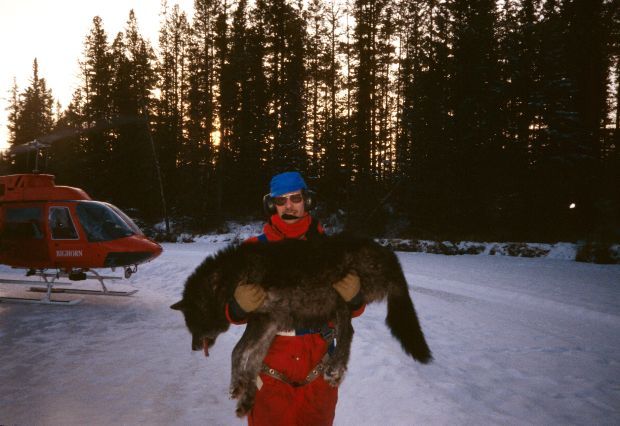
Mark
McNay, a retired biologist with Alaska Department of Fish and Game,
holds a tranquilized black wolf in Canada. The wolves were tested for
diseases in Canada before being flown south to Montana. (Photo by LuRay
Parker, Wyoming Game and Fish Department)
Decades after the last breeding pair
of wolves were shot in Wyoming, Renee Askins waited in a stuffy
conference room in Yellowstone National Park for a radio to crackle. She
hoped to hear the fate of 14 gray wolves captured in Canada and held at
three pens in the park. It was opening day, March 22, 1995, the day one
of the pens’ doors would be thrust ajar, freeing wolves to once again
roam Wyoming’s wilds.
The moment was 16 years in the making, and Askins was weary. Years of legal battles, contentious public meetings and death threats had taken their toll. She was ready to move past the conflict.
All that stood in the way were the animals themselves. But presented with their freedom, the newly formed packs had done what the world’s farthest-ranging predator had always done: They surprised Askins. None moved from the pens. “My own emotions were a roller coaster of anticipation and expectation that it’s going to happen,” she said. “And then we waited, and waited, and waited and tick, tick, tick, tick.”
A small group had gathered in the conference room to hear news of the opening. When the animals didn’t leave, they joked about welfare wolves sticking around for free food. They discussed what more could be done. Meanwhile, the wolves didn’t budge. Days passed.
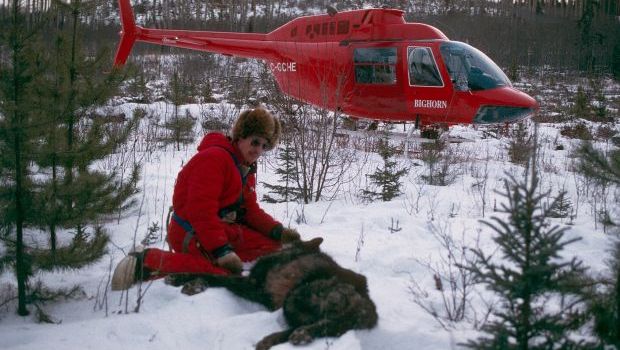
Two months earlier, the gray wolves caught in Canada were corralled in 1-acre pens in the park. If wolves spent a couple of months in an area, researchers thought they would be more willing to choose mates and would be less inclined to high-tail it back home.
Askins’ organization, and her future, depended on the carnivores loping out into the wild. When she created The Wolf Fund dedicated to reintroducing wolves into the West, she did what most other conservation groups would never consider: She gave it a sunset clause.
The Wolf Fund would dismantle as soon as wolves were loose in Yellowstone, read her bylaws. She would not continue the fight. She would not enter into courtrooms and join legal briefs and give impassioned arguments. She’d already done all of those things for nearly two decades.
Now all she could do was wait.
*****
No one event or person spurred the reintroduction of wolves into Idaho and Wyoming. A national fervor had been simmering since the U.S. Fish and Wildlife Service declared wolves endangered in the '70s. The ruling meant wolves should some day be restored to portions of their native range. Tens of thousands wrote the government in support, and in protest, of the possibility.
But ask around among those most involved in the saga of reintroduction, and one name is mentioned more than others: Renee Askins. Outside Magazine once said she was to wolves what Jane Goodall was to chimpanzees. Askins, 56, seldom gives interviews anymore. She wrote a book about her experiences, and references most reporters to those details.
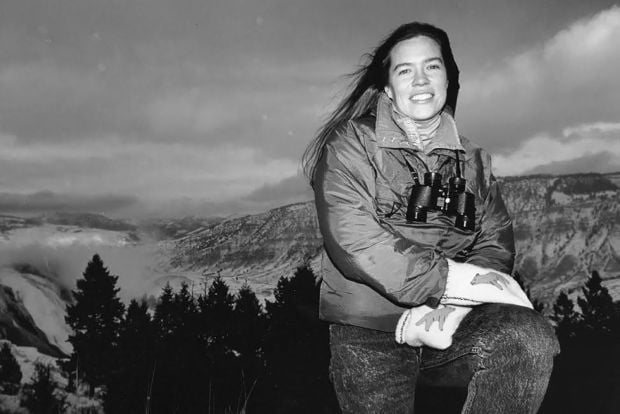
Wolves have other advocates now. Askins lives in Boston with her husband and daughter. A serious medical condition meant she had to leave Wyoming. Wolves became such a part of her identity, she sometimes introduces herself at dinner parties with her husband’s last name, Rush, instead of hers to avoid nightlong conversations about wolves, the wild and the West. “I never viewed the return of wolves to Yellowstone as a war, or its success as a ‘prize,’” she wrote in an email. “I genuinely saw it as an opportunity to correct a mistake, to right a wrong, to implement the knowledge and insight that clearly was lost in driving a species to extinction in our oldest national park.”
To right that wrong, as Askins saw it, would take more than tranquilizing wolves from a helicopter in Canada and carting them down to Yellowstone. Those were just logistics. It’s the human controversy involving people like her that captured the nation and divided the West. And even today, 20 years later, people remain split over whether those doors should have ever swung open.
*****
Askins’ story begins with a wolf named Natasha, a day-old, mouse-sized puppy at a research center called Wolf Park in Indiana. “Natasha had an independent and singular personality,” Askins said. “It wasn’t master and pet or mother and infant. It was being to being.”
Askins, who was 21 at the time, moved to Wolf Park to spend the spring working on her senior thesis.
Her project fit in a neat box. The alpha female, named Cassie, had been leader for nearly a decade. Each year, Cassie was the only female to give birth to a litter. Askins anticipated watching and recording how other pack members contributed to the survival of those puppies. Except the day after she arrived, Askins realized the first hard lesson of wolf biology: Wolves don’t do what people assume.
A spat over a carcass led a low-ranking female wolf to attack Cassie. The alpha female squealed, and the rest of the wolves attacked. Cassie was dead, and Askins’ research idea was shot.
Days later, the low-ranking female gave birth to two pups. One died quickly, the other was snatched up by the lead researcher. “He walked in here with this day-old wolf puppy, and he said, 'She’s your job,’” Askins said.

She named the pup Natasha and spent the next three weeks waking every two hours during the night to bottle-feed the helpless creature and hold her in a sling against her body to sleep. It wasn’t a choice. Her research work depended on her nurturing the animal. Then one day, a couple of months later, Askins’ boss told her Natasha would leave Indiana for a research facility in North Dakota.
In the wild, Natasha would have stayed with her pack. But Wolf Park had too many wolves and one had to go.
At the same time, she met John Weaver, a researcher in Montana, focused on restoring wolves into Yellowstone and the West. It was 1980, and wolf reintroduction was not yet part of a larger national dialogue.
Askins made a vow to Natasha before she left the research facility: Askins would help wolves return to the West, where they could exist without fences, cameras, log books and prying eyes.
The next year, Askins moved to Jackson and began working on possible reintroduction. Her aging grandmother made the journey with her from Askins’ childhood home in northern Michigan. When the pair crossed over the top of Togwotee Pass from Dubois to Jackson, they stared at the Tetons, and her grandmother asked her how long it would take to restore wolves to Yellowstone. Hopefully about a year, Askins replied.
*****
Soon after migrating to Wyoming, Askins moved into a teepee in a friend’s backyard. She was running on passion and enthusiasm more than money. Askins took whatever job came her way. She toiled on projects mapping nesting areas of great gray owls, helping sandhill cranes foster whooping crane orphans and monitoring winter mule deer habitat.
She did everything she could to help the wolf movement, which often felt like it was going nowhere.
“After about three or four years working for the agencies and conservation organizations, I started seeing we weren’t making progress,” Askins said. “It was going to take a far more sophisticated strategy and coordinated effort.”
Reintroducing wolves into the Yellowstone ecosystem was one of the most contested environmental debates of the time. The formal proposal received more than 160,000 comments. People appeared by the thousands at hearings and meetings across the Northern Rocky Mountains.
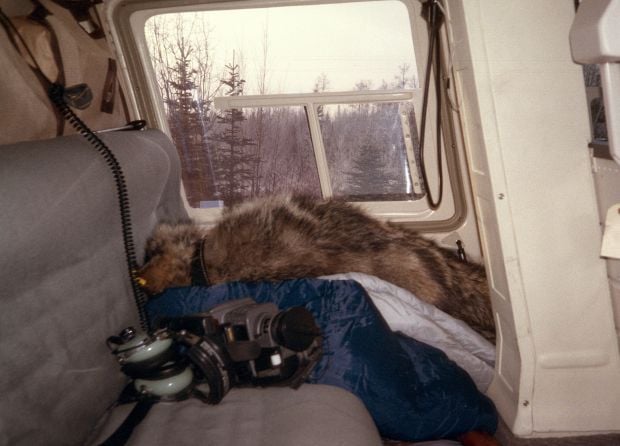
By 1986, talk of reintroducing wolves seemed to be gaining ground. On one side was the Fish and Wildlife Service, mandated by Congress to find a way to restore wolves to the areas they once had lived. Conservation groups like The Wolf Fund, Defenders of Wildlife and the National Wildlife Federation pursued a parallel effort to return to wolves to the greater Yellowstone area.
Some hunting groups and municipalities near the park even found themselves on the side of a managed wolf reintroduction because of worries over massive elk herds, said Hank Fischer, special projects coordinator for the National Wildlife Federation who worked on wolf reintroduction for Defenders of Wildlife for decades. "People felt there wasn't an ecological balance in the park because there weren't large carnivores," he said. "You didn't have large carnivores working on that elk population."
On the other side were cattle and sheep ranchers in Idaho, Montana and Wyoming, each terrified of what wolves could bring to their landscape and their businesses. Many had never dealt with wolves on the ground. “We introduced them into an area where there would be conflict,” said Albert Sommers, a rancher outside of Pinedale and Wyoming state legislator. “If people understood we would manage them and wolves would die, that is fine."
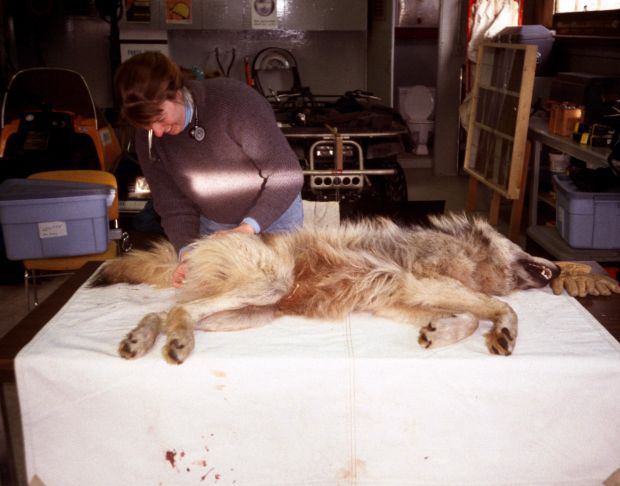
Janet Jones, a veterinarian from Banff, Canada, takes the temperature of a wolf in Canada as it is processed. (Photo by LuRay Parker, Wyoming Game and Fish Department)
To think wolves would arrive and leave livestock alone, Sommers said, was delusional. Askins agreed with some wolf removal. Those habituated to killing cattle or sheep needed to go. But she still believed wolves could live side by side with Wyoming’s livestock producers. “I didn’t see it as an us-and-them kind of thing. I had a great deal of sympathy, certainly for the ranchers that were in the immediate Yellowstone area, and felt very threatened by the possibility of wolves,” Askins said. “A lot of people would say to me, ‘It’s not the wolves we’re worried about, (rather) it’s what wolves represent.’”
Feelings about wolves, whether pro or con, go back centuries, said Ed Bangs, retired Fish and Wildlife Service gray wolf recovery coordinator. To some people wolves represent the wild and nature. To others, wolf reintroduction represented everything bad about government overreach.
“I’ve had ranchers come up to me after a meeting and say, ‘My granddad killed the last wolf in this valley.’ Symbolically it’s a big deal,” Bangs said. “They’re saying, ‘Are you telling me that’s wrong because he killed the last one?’”
But at the same time, wolves were making a decision for themselves. Gray wolves from Canada had already moved south into parts of northern Montana in the late 1980s. Their path to Wyoming looked inevitable. And if they came naturally, they would be given full protections under the Endangered Species Act, which meant fewer wolves could be killed for livestock protection and logging and mining could be more restricted.
If wolves were brought down and reintroduced as an experimental population, they could be established quicker, with genetic diversity, and managed much more effectively. Their eventual migration brought together unlikely allies between groups like The Wolf Fund and lawmakers such as the late U.S. Sen. James McClure, R-Idaho.
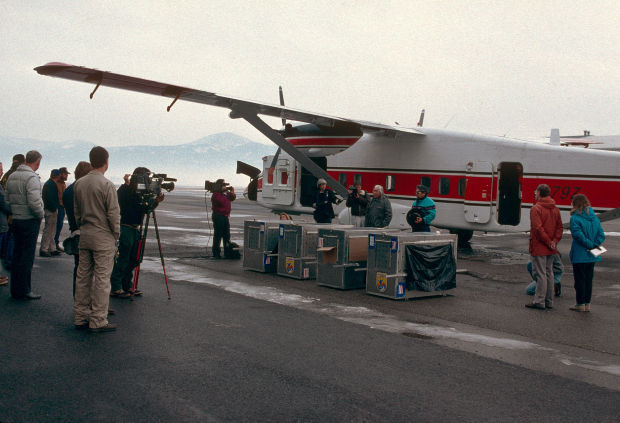
In the end it was clear: Wolves were coming, Askins said. All that was left to decide was how, when and under what protections. Those decisions would take more than a decade.
*****
The death threats bothered Askins, but not enough to quit. By the early '90s, when the reintroduction effort was in full swing, The Wolf Fund’s answering machine would light up in the mornings with everything from pledges of support by kindergarteners to profanity-laden messages not fit for a newspaper. “People said things like, ‘You’re not going to live to enjoy these wolves,’" she said, "or ‘You have no idea the harm these animals will do, and everything they do we’ll do to you.’”
One of most vocal opponents, ironically, was from a woman from Connecticut. Local ranchers, the ones who had been living and working in Wyoming for decades, Askins said she found chivalrous and willing to sit down and talk – even if both sides disagreed. “It was always the cowboys that got hired on for the summer that were from New Jersey or Florida and had so much to prove,” she said.
But by 1994, the reintroduction had taken a life of its own.
The Fish and Wildlife Service arranged for wolves to be caught in Canada and brought to Idaho and Yellowstone. Trappers darted them from planes and carried them south in small boxes. In January 1995, wolves were released into pens in Yellowstone. But even then, under the soft release, a judge could decide to have them killed. “That was a very vulnerable period, nobody knew just how far people would take it,” Askins said. Petitions had been filed on both sides – environmentalists seeking more protections than the nonessential designation, and ranchers maintaining the reintroduction was illegal.
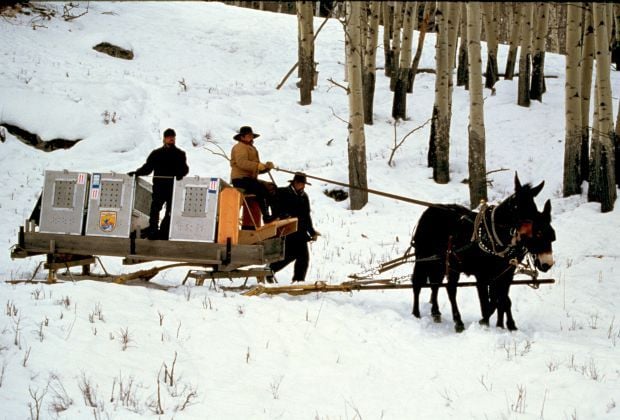
On March 21, 1995, wildlife officials in Yellowstone opened the first pen to free the wolves. Askins and others in The Wolf Fund hung a sign on the door that said “shut down” and informed callers the organization no longer existed. But then the wolves wouldn’t leave. On March 22, officials opened the next pen. The same thing. One wandered out and back in again, others wouldn’t go out at all.
“They never ceased to surprise me,” Askins said.
Biologists realized the wolves were wary of the only gate on their pens, the one where humans appeared regularly with food. Yellowstone National Park wolf managers cut a hole in a portion of the pens where the animals felt safe, and soon after, they began trickling out. Eventually each one had left, fading into the wild. Included in the group was a wolf Askins named Natasha, after the pup she’d tended so many years ago.
*****
Askins planned to move on from the wolf fight, but it was never her intention to move far from the animals themselves. She wanted to be a Wyoming resident, to hear wolves howl and know they roamed free. She wanted to raise her daughter in the wilds of northwest Wyoming in an ecosystem just a little closer to how it was before wolves were exterminated.
Instead, she, her husband and young daughter had to leave. An emergency surgery resulted in extensive nerve damage, and the resulting chronic pain and other complications required she live near a major medical facility with access to specialists. The family still has a house in Wilson, and Askins returns frequently. “I will heal, and I will return to my beloved Wyoming,” she said. “Hopefully to spend the rest of my life enjoying what I believe to be the most beautiful place on earth and its full complement of native wildlife.”
But 20 years after wolves were reintroduced into Yellowstone, their future in Wyoming remains in limbo. The animal has been removed from the endangered species list and placed back on it twice.
Legal arguments are at the center of the public debate. Some dispute Wyoming’s plan to allow wolves to be shot on site in 85 percent of the state. Others worry about a lack of genetic connectivity. Some want the state to have a larger buffer in minimum wolf numbers.
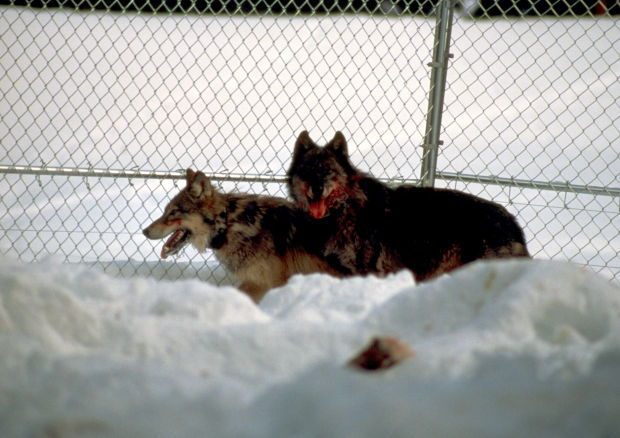
It’s a limbo that still troubles Askins. “I genuinely expected that much of the rhetoric and vitriol related to wolf symbolism would dissipate with the real presence of wolves. To some degree it has, but sadly, they are such a rich and tempting target to use for taunting, fundraising and firing up the ranks, some just find them too irresistible to exploit,” she said. “Most of all, I remain hopeful that reason and tolerance will ultimately prevail. Most Wyoming residents choose to live there because they have an inherent appreciation and respect for wild animals and wild places.”
source
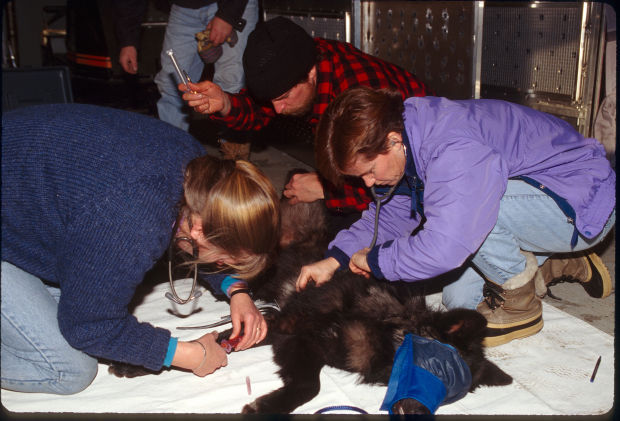

The moment was 16 years in the making, and Askins was weary. Years of legal battles, contentious public meetings and death threats had taken their toll. She was ready to move past the conflict.
All that stood in the way were the animals themselves. But presented with their freedom, the newly formed packs had done what the world’s farthest-ranging predator had always done: They surprised Askins. None moved from the pens. “My own emotions were a roller coaster of anticipation and expectation that it’s going to happen,” she said. “And then we waited, and waited, and waited and tick, tick, tick, tick.”
A small group had gathered in the conference room to hear news of the opening. When the animals didn’t leave, they joked about welfare wolves sticking around for free food. They discussed what more could be done. Meanwhile, the wolves didn’t budge. Days passed.

Mark
McNay, retired biologist with Alaska Department of Fish and Game, puts a
temporary tag on a wolf after it was darted for transfer to the
Canadian processing facility in January 1995. (Photo by Mark Bruscino,
Wyoming Game and Fish Department)
Two months earlier, the gray wolves caught in Canada were corralled in 1-acre pens in the park. If wolves spent a couple of months in an area, researchers thought they would be more willing to choose mates and would be less inclined to high-tail it back home.
Askins’ organization, and her future, depended on the carnivores loping out into the wild. When she created The Wolf Fund dedicated to reintroducing wolves into the West, she did what most other conservation groups would never consider: She gave it a sunset clause.
The Wolf Fund would dismantle as soon as wolves were loose in Yellowstone, read her bylaws. She would not continue the fight. She would not enter into courtrooms and join legal briefs and give impassioned arguments. She’d already done all of those things for nearly two decades.
Now all she could do was wait.
*****
No one event or person spurred the reintroduction of wolves into Idaho and Wyoming. A national fervor had been simmering since the U.S. Fish and Wildlife Service declared wolves endangered in the '70s. The ruling meant wolves should some day be restored to portions of their native range. Tens of thousands wrote the government in support, and in protest, of the possibility.
But ask around among those most involved in the saga of reintroduction, and one name is mentioned more than others: Renee Askins. Outside Magazine once said she was to wolves what Jane Goodall was to chimpanzees. Askins, 56, seldom gives interviews anymore. She wrote a book about her experiences, and references most reporters to those details.

From
a small wolf research park in Indiana to Yellowstone National Park,
Renee Askins played a long, instrumental role in reintroducing wolves to
their native range in the West. (Contributed)
Wolves have other advocates now. Askins lives in Boston with her husband and daughter. A serious medical condition meant she had to leave Wyoming. Wolves became such a part of her identity, she sometimes introduces herself at dinner parties with her husband’s last name, Rush, instead of hers to avoid nightlong conversations about wolves, the wild and the West. “I never viewed the return of wolves to Yellowstone as a war, or its success as a ‘prize,’” she wrote in an email. “I genuinely saw it as an opportunity to correct a mistake, to right a wrong, to implement the knowledge and insight that clearly was lost in driving a species to extinction in our oldest national park.”
To right that wrong, as Askins saw it, would take more than tranquilizing wolves from a helicopter in Canada and carting them down to Yellowstone. Those were just logistics. It’s the human controversy involving people like her that captured the nation and divided the West. And even today, 20 years later, people remain split over whether those doors should have ever swung open.
*****
Askins’ story begins with a wolf named Natasha, a day-old, mouse-sized puppy at a research center called Wolf Park in Indiana. “Natasha had an independent and singular personality,” Askins said. “It wasn’t master and pet or mother and infant. It was being to being.”
Askins, who was 21 at the time, moved to Wolf Park to spend the spring working on her senior thesis.
Her project fit in a neat box. The alpha female, named Cassie, had been leader for nearly a decade. Each year, Cassie was the only female to give birth to a litter. Askins anticipated watching and recording how other pack members contributed to the survival of those puppies. Except the day after she arrived, Askins realized the first hard lesson of wolf biology: Wolves don’t do what people assume.
A spat over a carcass led a low-ranking female wolf to attack Cassie. The alpha female squealed, and the rest of the wolves attacked. Cassie was dead, and Askins’ research idea was shot.
Days later, the low-ranking female gave birth to two pups. One died quickly, the other was snatched up by the lead researcher. “He walked in here with this day-old wolf puppy, and he said, 'She’s your job,’” Askins said.

Wolves
are driven into Yellowstone National Park under the Roosevelt Arch
outside of Gardiner, Montana. (Photo by Mark Bruscino, Wyoming Game and
Fish Department)
She named the pup Natasha and spent the next three weeks waking every two hours during the night to bottle-feed the helpless creature and hold her in a sling against her body to sleep. It wasn’t a choice. Her research work depended on her nurturing the animal. Then one day, a couple of months later, Askins’ boss told her Natasha would leave Indiana for a research facility in North Dakota.
In the wild, Natasha would have stayed with her pack. But Wolf Park had too many wolves and one had to go.
At the same time, she met John Weaver, a researcher in Montana, focused on restoring wolves into Yellowstone and the West. It was 1980, and wolf reintroduction was not yet part of a larger national dialogue.
Askins made a vow to Natasha before she left the research facility: Askins would help wolves return to the West, where they could exist without fences, cameras, log books and prying eyes.
The next year, Askins moved to Jackson and began working on possible reintroduction. Her aging grandmother made the journey with her from Askins’ childhood home in northern Michigan. When the pair crossed over the top of Togwotee Pass from Dubois to Jackson, they stared at the Tetons, and her grandmother asked her how long it would take to restore wolves to Yellowstone. Hopefully about a year, Askins replied.
*****
Soon after migrating to Wyoming, Askins moved into a teepee in a friend’s backyard. She was running on passion and enthusiasm more than money. Askins took whatever job came her way. She toiled on projects mapping nesting areas of great gray owls, helping sandhill cranes foster whooping crane orphans and monitoring winter mule deer habitat.
She did everything she could to help the wolf movement, which often felt like it was going nowhere.
“After about three or four years working for the agencies and conservation organizations, I started seeing we weren’t making progress,” Askins said. “It was going to take a far more sophisticated strategy and coordinated effort.”
Reintroducing wolves into the Yellowstone ecosystem was one of the most contested environmental debates of the time. The formal proposal received more than 160,000 comments. People appeared by the thousands at hearings and meetings across the Northern Rocky Mountains.

A
tranquilized wolf rests in the back of a helicopter in Canada while
being transported to a processing facility for examination. (Photo by
Mark Bruscino, Wyoming Game and Fish Department)
By 1986, talk of reintroducing wolves seemed to be gaining ground. On one side was the Fish and Wildlife Service, mandated by Congress to find a way to restore wolves to the areas they once had lived. Conservation groups like The Wolf Fund, Defenders of Wildlife and the National Wildlife Federation pursued a parallel effort to return to wolves to the greater Yellowstone area.
Some hunting groups and municipalities near the park even found themselves on the side of a managed wolf reintroduction because of worries over massive elk herds, said Hank Fischer, special projects coordinator for the National Wildlife Federation who worked on wolf reintroduction for Defenders of Wildlife for decades. "People felt there wasn't an ecological balance in the park because there weren't large carnivores," he said. "You didn't have large carnivores working on that elk population."
On the other side were cattle and sheep ranchers in Idaho, Montana and Wyoming, each terrified of what wolves could bring to their landscape and their businesses. Many had never dealt with wolves on the ground. “We introduced them into an area where there would be conflict,” said Albert Sommers, a rancher outside of Pinedale and Wyoming state legislator. “If people understood we would manage them and wolves would die, that is fine."

Janet Jones, a veterinarian from Banff, Canada, takes the temperature of a wolf in Canada as it is processed. (Photo by LuRay Parker, Wyoming Game and Fish Department)
To think wolves would arrive and leave livestock alone, Sommers said, was delusional. Askins agreed with some wolf removal. Those habituated to killing cattle or sheep needed to go. But she still believed wolves could live side by side with Wyoming’s livestock producers. “I didn’t see it as an us-and-them kind of thing. I had a great deal of sympathy, certainly for the ranchers that were in the immediate Yellowstone area, and felt very threatened by the possibility of wolves,” Askins said. “A lot of people would say to me, ‘It’s not the wolves we’re worried about, (rather) it’s what wolves represent.’”
Feelings about wolves, whether pro or con, go back centuries, said Ed Bangs, retired Fish and Wildlife Service gray wolf recovery coordinator. To some people wolves represent the wild and nature. To others, wolf reintroduction represented everything bad about government overreach.
“I’ve had ranchers come up to me after a meeting and say, ‘My granddad killed the last wolf in this valley.’ Symbolically it’s a big deal,” Bangs said. “They’re saying, ‘Are you telling me that’s wrong because he killed the last one?’”
But at the same time, wolves were making a decision for themselves. Gray wolves from Canada had already moved south into parts of northern Montana in the late 1980s. Their path to Wyoming looked inevitable. And if they came naturally, they would be given full protections under the Endangered Species Act, which meant fewer wolves could be killed for livestock protection and logging and mining could be more restricted.
If wolves were brought down and reintroduced as an experimental population, they could be established quicker, with genetic diversity, and managed much more effectively. Their eventual migration brought together unlikely allies between groups like The Wolf Fund and lawmakers such as the late U.S. Sen. James McClure, R-Idaho.

Officials
hold a press conference outside a U.S. Forest Service Sherpa airplane
before flying kenneled wolves from Canada to Great Falls, Montana, to go
through customs. (Photo by LuRay Parker, Wyoming Game and Fish
Department)
In the end it was clear: Wolves were coming, Askins said. All that was left to decide was how, when and under what protections. Those decisions would take more than a decade.
*****
The death threats bothered Askins, but not enough to quit. By the early '90s, when the reintroduction effort was in full swing, The Wolf Fund’s answering machine would light up in the mornings with everything from pledges of support by kindergarteners to profanity-laden messages not fit for a newspaper. “People said things like, ‘You’re not going to live to enjoy these wolves,’" she said, "or ‘You have no idea the harm these animals will do, and everything they do we’ll do to you.’”
One of most vocal opponents, ironically, was from a woman from Connecticut. Local ranchers, the ones who had been living and working in Wyoming for decades, Askins said she found chivalrous and willing to sit down and talk – even if both sides disagreed. “It was always the cowboys that got hired on for the summer that were from New Jersey or Florida and had so much to prove,” she said.
But by 1994, the reintroduction had taken a life of its own.
The Fish and Wildlife Service arranged for wolves to be caught in Canada and brought to Idaho and Yellowstone. Trappers darted them from planes and carried them south in small boxes. In January 1995, wolves were released into pens in Yellowstone. But even then, under the soft release, a judge could decide to have them killed. “That was a very vulnerable period, nobody knew just how far people would take it,” Askins said. Petitions had been filed on both sides – environmentalists seeking more protections than the nonessential designation, and ranchers maintaining the reintroduction was illegal.

Yellowstone
National Park officials bring wolves into acclimation pens by horse and
mule-drawn sleds. The pens were remote to keep the public away. (Photo
by LuRay Parker, Wyoming Game and Fish Department)
On March 21, 1995, wildlife officials in Yellowstone opened the first pen to free the wolves. Askins and others in The Wolf Fund hung a sign on the door that said “shut down” and informed callers the organization no longer existed. But then the wolves wouldn’t leave. On March 22, officials opened the next pen. The same thing. One wandered out and back in again, others wouldn’t go out at all.
“They never ceased to surprise me,” Askins said.
Biologists realized the wolves were wary of the only gate on their pens, the one where humans appeared regularly with food. Yellowstone National Park wolf managers cut a hole in a portion of the pens where the animals felt safe, and soon after, they began trickling out. Eventually each one had left, fading into the wild. Included in the group was a wolf Askins named Natasha, after the pup she’d tended so many years ago.
*****
Askins planned to move on from the wolf fight, but it was never her intention to move far from the animals themselves. She wanted to be a Wyoming resident, to hear wolves howl and know they roamed free. She wanted to raise her daughter in the wilds of northwest Wyoming in an ecosystem just a little closer to how it was before wolves were exterminated.
Instead, she, her husband and young daughter had to leave. An emergency surgery resulted in extensive nerve damage, and the resulting chronic pain and other complications required she live near a major medical facility with access to specialists. The family still has a house in Wilson, and Askins returns frequently. “I will heal, and I will return to my beloved Wyoming,” she said. “Hopefully to spend the rest of my life enjoying what I believe to be the most beautiful place on earth and its full complement of native wildlife.”
But 20 years after wolves were reintroduced into Yellowstone, their future in Wyoming remains in limbo. The animal has been removed from the endangered species list and placed back on it twice.
Legal arguments are at the center of the public debate. Some dispute Wyoming’s plan to allow wolves to be shot on site in 85 percent of the state. Others worry about a lack of genetic connectivity. Some want the state to have a larger buffer in minimum wolf numbers.

Two
wolves are pictured together inside an acclimation pen in Yellowstone
National Park in early 1995. Acclimation pens were located in remote
areas of the park to keep the wolves away from people while they bonded,
formed pairs and mated before being released into the park. (Photo by
LuRay Parker, Wyoming Game and Fish Department)
It’s a limbo that still troubles Askins. “I genuinely expected that much of the rhetoric and vitriol related to wolf symbolism would dissipate with the real presence of wolves. To some degree it has, but sadly, they are such a rich and tempting target to use for taunting, fundraising and firing up the ranks, some just find them too irresistible to exploit,” she said. “Most of all, I remain hopeful that reason and tolerance will ultimately prevail. Most Wyoming residents choose to live there because they have an inherent appreciation and respect for wild animals and wild places.”
source

Janet
Jones, Mark Johnson and Beth Regehr perform a physical examination on a
captured wolf in Alberta, Canada, in Dec. 1994. Each animal was
examined by a veterinarian prior to being transported to the United
States for reintroduction. (Photo by LuRay Parker, Wyoming Game and Fish
Department)

Radio
collars decorated by young students sit ready for wolf reintroduction
in Jan. 1995 in Yellowstone National Park. (Photo by Mark Bruscino,
Wyoming Game and Fish Department)
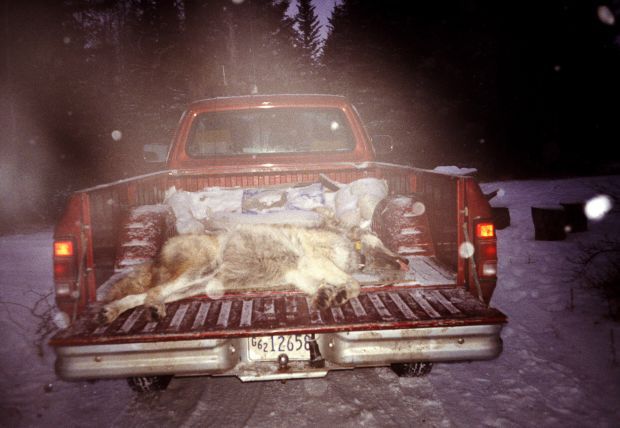

Canadian
wolves lay tranquilized in the back of a truck before being driven to
veterinarians for processing. Wolves caught for reintroduction had to be
certified disease free before being sent to the U.S. Each night blood
samples were sent to a lab in Calgary. (Photo by Mark Bruscino, Wyoming
Game and Fish Department)


No comments:
Post a Comment